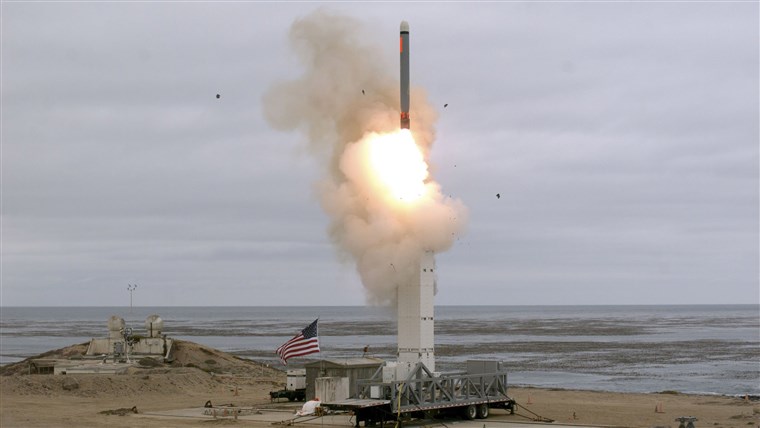
Sunday’s US Missile Launch, Explained.
Arms Control Twitter has been abuzz since yesterday’s announcement that the United States had conducted a surprise launch of a Tomahawk missile on Sunday afternoon.
This wasn’t just your regular missile launch, however. It was a Tomahawk cruise missile launched from a ground-based Mark-41 Vertical Launch System (VLS), traveling to a distance of “more than 500 kilometers,” according to the Department of Defense.
In other words: a violation of the Intermediate-Range Nuclear Forces (INF) Treaty––if the treaty still existed. It officially died on August 2nd, six months after both the United States and Russia announced suspensions of their respective treaty obligations. But the launch is an important walk-back of US security policy which for 32 years sought to curtail such weapons and instead, as we have written for the Bulletin of the Atomic Scientists, makes the United States needlessly complicit in the INF’s demise and frees Russia from both the responsibility and pressure to return to compliance.
The launch was a bit of a surprise, but we knew it was coming. As early as March, US defense officials announced that DoD would test two missiles after the treaty expired on August 2nd: a ground-launched Tomahawk in August and a ground-launched ballistic missile in November.
Although the US test isn’t an official INF violation (because the treaty is dead), the timing and characteristics of the test itself has raised a few popular questions, which we will answer below:
The test took place only 16 days after INF died. That’s awfully quick to develop this missile configuration––does it mean that the United States was secretly violating the treaty this entire time?
No. Sunday’s test features an existing missile being launched from an existing missile launcher. It isn’t exactly a difficult engineering feat to cobble this together on short notice.
In fact, one of the most interesting things about the video is the haphazard nature of the test itself. As pointed out by Michael Duitsman, it looks like the Pentagon simply bolted a VLS launcher to a semi-trailer, planted a giant American flag nearby, and launched.
Why is everyone so worked up about the launcher?
This is where things get really interesting. The Mk-41 VLS launcher that was used to launch the Tomahawk is the same type of launcher that would be used to launch SM-3 interceptors from Aegis Ashore ballistic missile defense stations in Romania and Poland, once the latter station is completed.
For years, Russia has said that the US deployment of these ground-based Mk-41 VLS launchers to Europe constitutes an INF violation, because they could theoretically be used to launch Tomahawks over 500 kilometers. Legally speaking, this doesn’t hold water––Article VII, paragraph 7 of the INF Treaty states that in order for a launcher to be considered in violation of the treaty, it must actually conduct a ground launch of a prohibited missile. Since this never happened while the INF Treaty was in force, the Mk-41 VLS launchers weren’t in violation.
What’s more, the United States has consistently stated that although Mk-41s can launch Tomahawks, the ones deployed in Romania and Poland cannot. In December 2017, the State Department announced that “The Aegis Ashore Missile Defense System does not have an offensive ground-launched ballistic or cruise missile capability. Specifically, the system lacks the software, fire control hardware, support equipment, and other infrastructure needed to launch offensive ballistic or cruise missiles such as the Tomahawk.”
Perhaps this is true, perhaps it isn’t. But absent some kind of US transparency measure that offers visibility into the Aegis Ashore systems, Russia is forced to rely solely on an American promise. And for Putin, that’s simply not going to cut it. That being said, it’s also possible that no amount of transparency would ever have satisfied Putin, as his primary concern over Aegis Ashore appears to be directed at the general deployment of missile defenses in Europe, rather than their offensive potential.
So why did the United States do this test?
Both the timing and the nature of the test indicate that it’s driven primarily by political––rather than strategic––considerations. In all likelihood, the Trump administration asked the Pentagon to conduct an INF-violating test under a very tight timeline, and the quickest option also happened to be the most controversial. Also, any chance to give the INF Treaty’s corpse the middle finger is one that this administration will surely take.
Unfortunately, the test will almost certainly further entrench Russia’s suspicions of US missile defense deployments in Europe as well as enable the Kremlin to paint the United States as the problem rather than Russia.
And China can now feel completely vindicated in its decision not to join arms control talks or limitations. After all, why would it do so when it has far fewer nuclear weapons than both Russia and the United States, or consider limiting its INF-range missiles when Russia, India, and now the United States, are all developing such weapons?
With this flight test, the Trump administration has placed the United States firmly in the group of nations that it previously criticized for developing INF-range weapons. Instead of seeking to build international pressure against INF-missile proliferation, the Trump administration has needlessly surrendered the legal and political high-ground the United States previously had, and has now become part of the problem.
The Federation of American Scientists applauds the United States for declassifying the number of nuclear warheads in its military stockpile and the number of retired and dismantled warheads.
North Korea may have produced enough fissile material to build up to 90 nuclear warheads.
Secretary Austin’s likely certification of the Sentinel program should be open to public interrogation, and Congress must thoroughly examine whether every requirement is met before allowing the program to continue.
Researchers have many questions about the modernization of Pakistan’s nuclear-capable aircraft and associated air-launched cruise missiles.